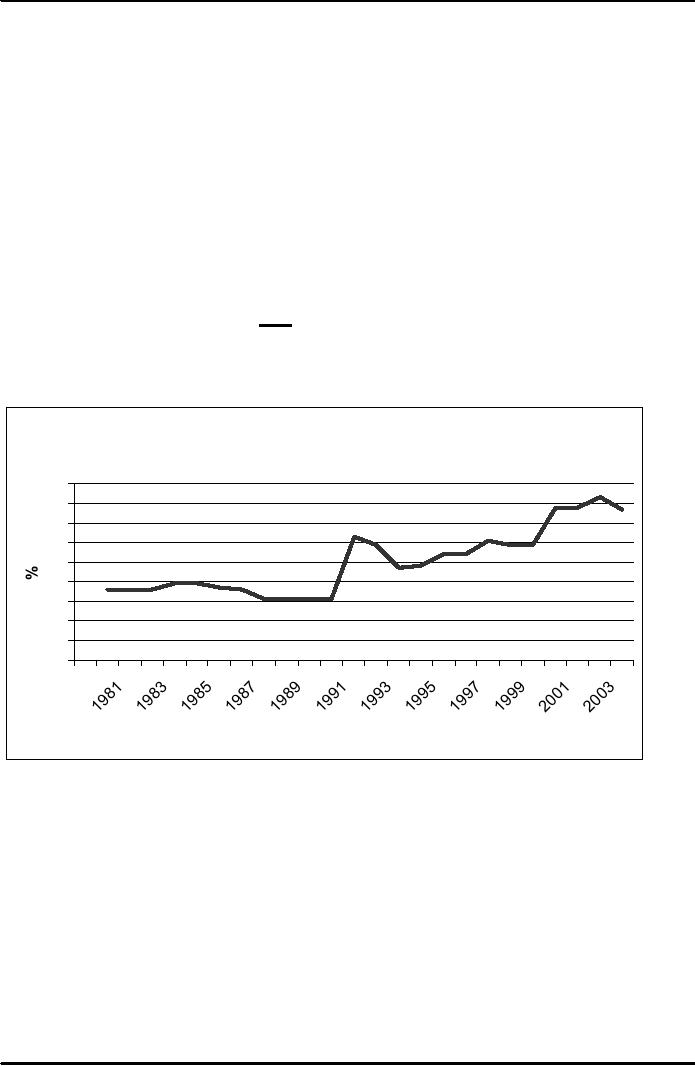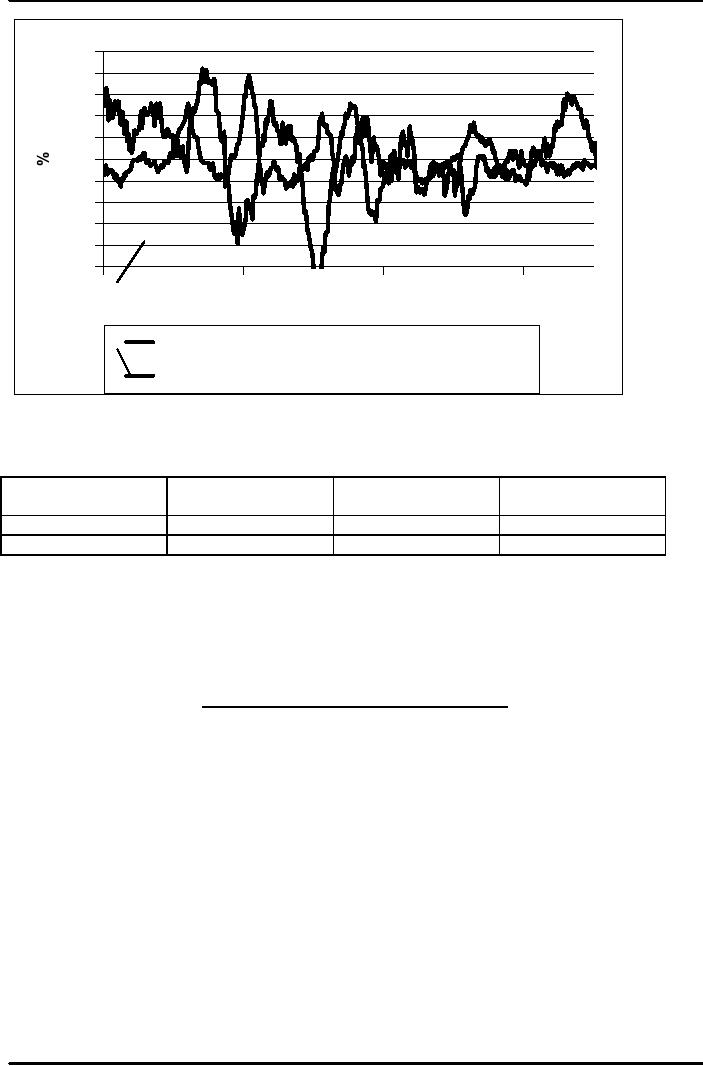 |
IMPORTANCE OF MACROECONOMICS:Interest rates and rental payments |
| << PRINCIPLE OF MACROECONOMICS:People Face Tradeoffs |
| THE DATA OF MACROECONOMICS:Rules for computing GDP >> |

Macroeconomics
ECO 403
VU
LESSON
03
IMPORTANCE OF
MACROECONOMICS
Why learn
macroeconomics?
1.
The macroeconomy affects
society's well-being.
example:
Unemployment
and social problems
Each
one-point increase in the
unemployment rate is associated
with:
920
more suicides
650
more homicides
4000
more people admitted to
state mental
institutions
3300
more people sent to state
prisons
37,000
more deaths
increases
in domestic violence and
homelessness
The
macroeconomy affects your
well-being.
example
1:
Unemployment
and earnings growth
example
2:
Interest
rates and mortgage
payments
Unemployment
Rate of Pakistan
9
8
7
6
5
4
3
2
1
0
Years
6

Macroeconomics
ECO 403
VU
Unemployment
and Earnings
Growth
5
4
3
2
1
0
-1
-2
-3
Inflation
Growth rate
-4
-5
1965
1975
1985
1995
growth
rate of inflation-adjusted hourly
earnings
change
in Unemployment rate
Interest
rates and rental
payments
For
a Rs.320,000; 3-year
mortgage
Date
actual
rate on 3-
monthly
payment
annual
payment
year
financing
May
2003
8.50%
Rs.
10,021
Rs.
120,252
May
2004
7.25%
Rs.
9,839
Rs.
118,068
Why
learn macroeconomics?
3.
The macroeconomy affects
politics & current
events.
·
example:
Inflation
and unemployment in election
years
Inflation
and Unemployment in Election
Years
Year
U
rate
inflation
rate
1976
7.7%
5.8%
1980
7.1%
13.5%
1984
7.5%
4.3%
1988
5.5%
4.1%
1992
7.5%
3.0%
1996
5.4%
3.3%
2000
4.0%
3.4%
Economic
models
...are
simplified versions of a more
complex reality
·
irrelevant
details are stripped
away
Used
to
·
show
the relationships between
economic variables
·
explain
the economy's
behavior
·
devise
policies to improve economic
performance
The
supply & demand for new
cars
7

Macroeconomics
ECO 403
VU
explains
the factors that determine
the price of cars and
the quantity sold.
·
assumes
the market is competitive:
each buyer and seller is
too small to affect
the
·
market
price
·
Variables:
Q
d = quantity of cars that
buyers demand
Q
s = quantity that producers
supply
P
= price of new cars
Y
= aggregate income
Ps
= price of steel (an
input)
The
demand for cars
Demand
Equation
Qd
= D(P,Y)
shows
that the quantity of cars
consumers demand is related to
the price of cars
and
aggregate
income.
·
General
functional notation shows
only that the variables
are related:
Qd =
D(P,Y)
8
Table of Contents:
- INTRODUCTION:COURSE DESCRIPTION, TEN PRINCIPLES OF ECONOMICS
- PRINCIPLE OF MACROECONOMICS:People Face Tradeoffs
- IMPORTANCE OF MACROECONOMICS:Interest rates and rental payments
- THE DATA OF MACROECONOMICS:Rules for computing GDP
- THE DATA OF MACROECONOMICS (Continued…):Components of Expenditures
- THE DATA OF MACROECONOMICS (Continued…):How to construct the CPI
- NATIONAL INCOME: WHERE IT COMES FROM AND WHERE IT GOES
- NATIONAL INCOME: WHERE IT COMES FROM AND WHERE IT GOES (Continued…)
- NATIONAL INCOME: WHERE IT COMES FROM AND WHERE IT GOES (Continued…)
- NATIONAL INCOME: WHERE IT COMES FROM AND WHERE IT GOES (Continued…)
- MONEY AND INFLATION:The Quantity Equation, Inflation and interest rates
- MONEY AND INFLATION (Continued…):Money demand and the nominal interest rate
- MONEY AND INFLATION (Continued…):Costs of expected inflation:
- MONEY AND INFLATION (Continued…):The Classical Dichotomy
- OPEN ECONOMY:Three experiments, The nominal exchange rate
- OPEN ECONOMY (Continued…):The Determinants of the Nominal Exchange Rate
- OPEN ECONOMY (Continued…):A first model of the natural rate
- ISSUES IN UNEMPLOYMENT:Public Policy and Job Search
- ECONOMIC GROWTH:THE SOLOW MODEL, Saving and investment
- ECONOMIC GROWTH (Continued…):The Steady State
- ECONOMIC GROWTH (Continued…):The Golden Rule Capital Stock
- ECONOMIC GROWTH (Continued…):The Golden Rule, Policies to promote growth
- ECONOMIC GROWTH (Continued…):Possible problems with industrial policy
- AGGREGATE DEMAND AND AGGREGATE SUPPLY:When prices are sticky
- AGGREGATE DEMAND AND AGGREGATE SUPPLY (Continued…):
- AGGREGATE DEMAND AND AGGREGATE SUPPLY (Continued…):
- AGGREGATE DEMAND AND AGGREGATE SUPPLY (Continued…)
- AGGREGATE DEMAND AND AGGREGATE SUPPLY (Continued…)
- AGGREGATE DEMAND AND AGGREGATE SUPPLY (Continued…)
- AGGREGATE DEMAND IN THE OPEN ECONOMY:Lessons about fiscal policy
- AGGREGATE DEMAND IN THE OPEN ECONOMY(Continued…):Fixed exchange rates
- AGGREGATE DEMAND IN THE OPEN ECONOMY (Continued…):Why income might not rise
- AGGREGATE SUPPLY:The sticky-price model
- AGGREGATE SUPPLY (Continued…):Deriving the Phillips Curve from SRAS
- GOVERNMENT DEBT:Permanent Debt, Floating Debt, Unfunded Debts
- GOVERNMENT DEBT (Continued…):Starting with too little capital,
- CONSUMPTION:Secular Stagnation and Simon Kuznets
- CONSUMPTION (Continued…):Consumer Preferences, Constraints on Borrowings
- CONSUMPTION (Continued…):The Life-cycle Consumption Function
- INVESTMENT:The Rental Price of Capital, The Cost of Capital
- INVESTMENT (Continued…):The Determinants of Investment
- INVESTMENT (Continued…):Financing Constraints, Residential Investment
- INVESTMENT (Continued…):Inventories and the Real Interest Rate
- MONEY:Money Supply, Fractional Reserve Banking,
- MONEY (Continued…):Three Instruments of Money Supply, Money Demand